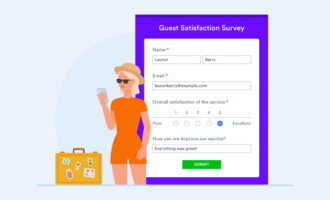Business leaders are like ship captains. If they’re not steering the company in the right direction, it isn’t likely to reach its desired destination.
While many people believe they should be in leadership positions, only 10 percent of people are, in fact, naturally good at leading others, while another 20 percent show some management talent that can develop into leadership qualities.
To ensure your company is in the right hands, it’s wise to conduct leadership surveys on a regular basis. Surveys can help you determine whether you have the right leaders in place and how employees perceive them.
In this article, we’ll look at the benefits of conducting leadership surveys, offer tips for creating effective leadership surveys, and provide examples of leadership survey questions you can use. Finally, we’ll show you a tool that makes surveying a snap.
The best times to conduct leadership surveys
Leadership surveys offer organizations valuable insights about the people at the helm. However, to truly benefit from these surveys — and ensure the findings inform business decisions — you have to get the timing right. The best times to conduct a leadership survey are
- When your organization is evaluating its current leadership
- When you’re considering appointing a new leader
- When you’re considering making major organizational changes that will specifically impact the C-suite
Surveying at these times in particular will help you evaluate the strengths, skills, and growth areas of leaders — current or future — and determine whether they’re positioned to steer your organization toward your future goals. If there’s a mismatch between what leadership offers and what your organization wants to achieve, you can identify the gaps early and look for a new leader to take charge.
Tips for creating an effective leadership survey
Creating a survey is part art and part science. You have to use the right type of question formats, ensure the phrasing of the questions is clear, and put the questions in the right order. Follow these best practices to conduct a comprehensive and informative leadership survey:
- Have a clear goal. Determine specifically what you want to know. For example, are you trying to assess the leader’s overall performance? Are you interested in learning about the effectiveness of their communication style or whether they’re an inspirational leader?
- Cater to one audience at a time. Your leadership survey should speak to one audience, such as the leaders themselves or the employees. Avoid using the same questions for multiple audiences, as they may not be relevant or provide you with useful insights.
- Determine mandatory and optional questions. Figure out which questions you specifically need answers for and which questions are nice to have. This way, you can reduce survey fatigue, since some people may not want to respond to every question in the survey.
- Use branching logic. Ensuring leadership questions are relevant to the audience is key to getting high-quality survey responses. Branching or conditional logic serves up relevant questions based on the answers the responder has provided to previous questions.
- Have a plan for analyzing responses. If you don’t do anything with the data you’ve gathered, your respondents may not be willing to complete another survey in the future. Have a process for analyzing the data and turning it into an action plan for the organization.
Create a leadership survey preloaded with these 15 questions.
Examples of leadership survey questions
Self-assessment questions
Self-assessment questions enable organizations to determine how the leader feels about their own performance. This is a good way to see whether the leader’s perception of themselves matches others’ perceptions.
- Have you met your own expectations this fiscal year? If the answer for this question differs greatly from the leader’s actual performance, the organization may need to provide some additional training.
- How do you help others achieve their goals? Leaders need to know how to support their team through training and development, mentorship, coaching, and additional resources.
- How well do you handle criticism of your skills and performance? Not everyone can take constructive criticism. It requires humility to accept it and learn from it.
- Do you take responsibility for your team when they don’t meet their targets? If a leader takes credit for their teams’ successes but not their shortfalls, this can lead to distrust among team members and impact their loyalty to the leader.
- How do you inspire your team to meet company goals? Part of the leader’s role is to motivate their employees to do their best work, whether it’s through coaching sessions, motivational speeches, competitive examples, rewards, or something else.
Feedback questions
These questions are for employees and may focus on specific aspects of the leader’s performance as well as their skills, such as communication or negotiation.
- How would you rate the leadership team’s performance this fiscal year? It’s important to know the overall sentiment of the employees in regard to the leadership at the company. Whether it’s negative or positive, this information can help you determine if you need to make any changes or continue with certain elements.
- What are the biggest leadership gaps you see in the organization? Employees may provide insight the executive team is unaware of, such as specific skills the leaders lack or projects they need to be more aware of.
- Do you feel inspired by the leadership team? If the leadership team seems lackluster, uninterested, or unapproachable, employees may not feel motivated to perform at their highest level.
- Do you have an opportunity to share ideas and feedback with the leadership team? It’s important for leaders to have a process in place where employees feel comfortable sharing ideas, feedback, and suggestions for improvement — without any negative repercussions.
- If you were in a leadership role in the company, what would be your first task? This question can help the organization determine employees’ priorities. If this list differs greatly from what leaders prioritize, there may be a bigger issue that needs addressing.
Competency questions
Gathering feedback on a leader’s specific skills is a good way to determine whether they’re the right person to lead the organization. While these questions are framed for employees, you can easily turn them into self-evaluation questions as well.
- In your opinion, does your manager have the necessary skills, experience, and knowledge to effectively lead the team to achieve their goals? This question assesses the overall level of confidence the team has in their leader and their ability to steer the organization in the right direction.
- Does your manager consistently make decisions that have a positive impact on the organization? One of the most important duties leaders are charged with is making decisions. If decision-making isn’t a core strength — or team members don’t see it as one — this could be a problem.
- Do you feel confident in the leader’s ability to communicate goals, instructions, and company direction? Being able to communicate well both verbally and through writing should be a priority for someone in a leadership position. This question helps you determine how employees perceive the leader’s communication skills.
- Does your manager offer constructive feedback to strengthen your skills and help you achieve professional goals? Leaders need to be able to provide support and guidance to their team. This not only improves team performance but also helps the company achieve its goals.
- Does your manager hold team members — and themselves — accountable for their actions and decisions? Taking responsibility for both negative and positive consequences is key. It’s easier for everyone to do that when managers lead by example and hold themselves accountable for their own actions.
Growth mindset questions
Leadership isn’t about standing still. It’s all about moving forward — and taking the company and the team to the next level. These questions are a great way to gauge whether the current leadership has a growth mindset.
- Have you observed the leaders of the company reframing mistakes and setbacks as opportunities to learn and improve? The answers to this question can be very telling. A leader who moves on quickly from mistakes without looking at why they occurred likely isn’t thinking about what they can learn from them.
- Does your manager encourage you to pursue continuous learning to improve your skills and abilities? Many organizations have learning and development budgets, but it’s up to managers to motivate employees and give them the time to actually take part in learning activities.
- How confident are you that the leadership of this organization takes employee feedback into account when adopting strategies? Employees often have excellent ideas on how to take the company forward. This question shows you whether leaders can spot excellent feedback and put it into action.
- Does your manager encourage taking measured risks? No risk, no reward, as the saying goes. Often, innovation and out-of-the-box thinking happen when employees are given opportunities to take certain risks within their work.
- Do you believe the leadership team is working to improve their own skills in order to further their professional development? Employees like to see a growth mindset exemplified. To create a culture of growth, leaders need to show employees their own willingness to grow and develop.
Compassion and empathy questions
Does a leader care about their employees? That’s one of the most important questions an organization can ask. After all, if a leader doesn’t show any compassion or empathy toward employees, many are bound to walk away eventually.
- Do you feel your manager understands your personal and professional challenges? This question is a great way to gauge whether employees feel the leadership team hears and understands them.
- Do you feel comfortable discussing your personal and professional challenges with your manager? If the answer to this question is no, that means the organization needs to do plenty of work to help employees feel more comfortable sharing their troubles.
- Do you feel your manager respects your personal time outside of work? Work-life balance is key for employees. If employees feel the leadership team doesn’t respect that balance, it can lead to stress and turnover.
- Do you feel valued and appreciated by your manager for all your efforts? Employees need to see that the leadership team recognizes their work through promotions, raises, bonuses, and praise.
- Does your manager treat everyone on the team equitably? Sometimes personal biases can get in the way of treating employees fairly. This question is a good way to determine whether a leader understands the importance of equity.
Diversity and inclusion questions
Employees want to have a sense of belonging in the organization, and it’s up to the leadership team to set the tone. Ask these diversity and inclusion questions to get a sense of the importance leaders place on belonging.
- Does your manager embrace diverse ideas and perspectives? A diversity of thought is important within an organization because it helps people think outside the box.
- Do the organization’s hiring practices reflect its diversity and inclusion policies? Sometimes actions don’t align with words. This question helps organizations determine whether leaders really prioritize diversity and inclusion.
- How does your manager handle issues that arise as a result of diversity within the team? It’s natural for challenges to emerge within a diverse group of people. What matters is how the leader resolves those challenges.
- Does the leadership team provide adequate training for employees around diversity and inclusion topics? While the concept of diversity and inclusion isn’t new, training is still necessary for employees. Leaders should prioritize this training to create a welcoming and equitable culture.
- Does your manager celebrate diversity? Acknowledging diversity is one thing, but celebrating it is another. Employees want to feel welcomed at a company, no matter their background or identity.
Empowerment and motivation questions
The best leaders are skilled at empowering and motivating the rest of the team. If they don’t inspire employees to achieve greatness, the organization may not be able to reach its goals.
- How confident are you in the leader’s ability to get employees excited about work? Work doesn’t have to feel like a chore. This question shows whether the leader is able to make employees feel happy and energized about their contributions.
- Does your manager provide you with time and resources to upskill or reskill? Employees need more than motivation to improve themselves. This question helps organizations determine whether they’re enabling employees to achieve their professional goals.
- Does your manager inspire you to achieve new goals? This question is a great indicator of how empowering and encouraging a leader is when it comes to helping team members identify and pursue goals.
- How does your manager help you grow professionally? Ask this question to learn more about the different ways leaders empower employees, such as through mentorship, training, guidance, and more.
- Does your manager do a good job of connecting your contributions to the larger goals of the organization? Employees want to understand how their work affects the performance of the organization, as it gives their tasks more meaning.
The benefits of delivering leadership survey questions with Jotform
Jotform is an excellent tool for organizations that want to gain critical feedback from their leadership team as well as their employees. This survey software is ideal for asking leadership survey questions and managing many other business-critical processes.
Jotform comes with ready-to-use leadership survey templates, including a leadership skills survey, a health and safety leadership survey, a self-assessment survey, a leadership feedback form, and evaluation forms. Building a survey from scratch or customizing a survey template is easy with Jotform’s drag-and-drop interface. You can quickly change the content, layout, or design of the form and then distribute it over email, link, QR code, or website embed.
All survey responses collected through Jotform are highly secure, so you don’t need to worry about confidential information getting into the wrong hands. Jotform’s Report Builder can also automatically convert survey responses into actionable visual reports that you can use to improve your organization’s leadership.
Get started building your own leadership survey now — simply sign up for a free Jotform account, choose your template, and begin crafting your questions.
Photo by Memento Media on Unsplash






































































































Send Comment: